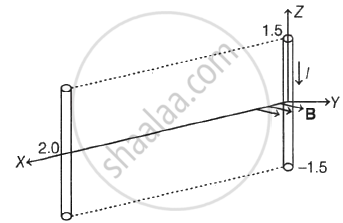Advertisements
Advertisements
Question
Prove that an ideal capacitor in an AC circuit does not dissipate power
Solution
In an AC circuit containing only an ideal capacitor, the current i leads the emf e by a phase angle of π/2 rad.
Here, for e = e0 sin wt, we have, i = i0 sin (ωt + π/2) Instantaneous power, P = ei
= (e0 sin ωt)[i0 (sin ωt cos π/2 + cos ωt sin π/2)]
= e0i0 sin ωt cos ωt as cos π/2 = 0 and sin π/2 = 1
Average power over one cycle, Pav
`= "work done in one cycle"/"time for one cycle"`
`= (int_0^"T" "P dt")/"T" = (int_0^"T" "e"_0"i"_0 sin omega"t" cos omega"t" "dt")/"T"`
`= ("e"_0"i"_0)/"T" = int_0^"T" sin omega"t" cos omega"t dt"`
Now, `int_0^"T" sin omega"t" cos omega"t dt" = 0`
∴ Pav = 0, i.e., the circuit does not dissipate power.
[Note: For reference, see the answer Q.6. The proof should be wriiten as part of the answer.]
APPEARS IN
RELATED QUESTIONS
Obtain an expression for average power dissipated in a purely resistive A.C. circult.
A resistor of 500 Ω and an inductance of 0.5 H are in series with an AC source which is given by V = `100 sqrt2` sin (1000 t). The power factor of the combination is ______.
In a series LCR circuit, the phase difference between the voltage and the current is 45°. Then the power factor will be ______.
Answer in brief.
What is wattles current?
(a) An emf e = e0 sin ωt applied to a series L - C - R circuit derives a current I = I0sinωt in the circuit. Deduce the expression for the average power dissipated in the circuit.
(b) For circuits used for transporting electric power, a low power factor implies large power loss in transmission. Explain.
An AC source generating a voltage e = e0sinωt is connected to a capacitor of capacitance C. Find the expression for the current i flowing through it. Plot a graph of e and i versus ωt.
A light bulb is rated 100W for 220 V AC supply of 50 Hz. Calculate
- resistance of the bulb.
- the rms current through the bulb
An AC circuit consists of only an inductor of inductance 2 H. If the current is represented by a sine wave of amplitude 0.25 A and frequency 60 Hz, calculate the effective potential difference across the inductor. (π = 3.142)
A 25 μF capacitor, a 0.10 H inductor, and a 25Ω resistor are connected in series with an AC source whose emf is given by e = 310 sin 314 t (volt). What is the frequency, reactance, impedance, current, and phase angle of the circuit?
What is meant by wattles current?
Give any one definition of power factor.
In series 'LR' circuit and in series 'RC' circuit, same current is flowing. If the frequency of e.m.f. of a.c. is increased for both the circuits, the impedance will ____________.
In LCR series circuit, an alternating e.m.f. 'e' and current 'i' are given by the equations e = 100 sin (100 t) volt,
`"i" = 100 "sin" (100"t" + pi/3)"mA"`.
The average power dissipated in the circuit will be ____________.
An e.m.f. E = E0 sin `omega`t is applied to a circuit containing 'L' and 'R' in series. If XL = R, then the power dissipated in the circuit is ____________.
The voltage gain of a CE amplifier is 50. A sinusoidal ac of amplitude 10 mV is applied as a signal. The output of the amplifier will be ______.
In series LCR circuit R = 18 Ω and impedance is 33 Ω An rms voltage 220V is applied across the circuit. The ture power consumed in AC circuit is ______.
A conductor lies along the Z-axis at −1.5 ≤ Z ≤ 1.5 m and carries a fixed current of 10.0 A in −az direction as (see figure). For a field B = 3.0 × 10−4`"e"^(−0.2"x")`ay T, find the power required to move the conductor at constant speed to x = 2.0 m, y = 0 in 5 × 10−3 s. Assume parallel motion along the x-axis.

What is the average value of alternating current over a complete cycle?
Explain the theory of an AC circuit with a resistor.
Where is the power dissipated in an alternating current circuit?
